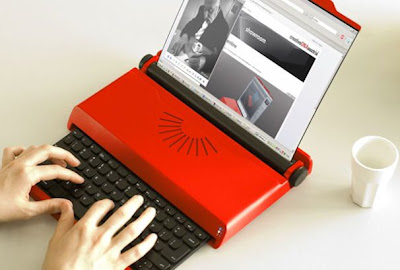What will laptops look like in five years? Or may be next Ten? Predicting future tech trends is always tricky, but these notebook concepts from both PC makers and straight-up tech fans provide a few clues as to what could lie ahead.
Many of these concepts may never leave the drawing board or lab, but we can always dream…and in some cases, be thankful. So here we go.....
D-roll
Designer Hau Hou's radical redesign of the laptop replaces the conventional clamshell with a lightweight, foldable roll modeled after artists' storage tubes. The flexible OLED screen and arc-shaped keyboard fold into the tube when not in use, and the carrying strap features a few easy-to-access USB ports. How about naming it the Stag Beetleinstead?

Rolltop
This effort fromOrkin Design has much in common with the D-roll in that both designs fold into an easy-to-carry tube when not in use. But unlike the D-roll, the Rolltop also lies flat for tablet use. The tube packs the power supply, a Webcam, USB ports, speakers, and an extendable power cord. A flexible OLED display, a screen keyboard, and a stylus (for tablet writing) round out the feature set.
Projection PCs
Why bother with a space-hogging keyboard and monitor when a humble pen would suffice? Researchers are developing Projector PC's capable of projecting a computer display and a touchscreen-like virtual keyboard on a smooth surface, such as your desk.
Flexible Displays
Your laptop, tablet, or e-reader may soon have a flexible display rather than a rigid glass screen that can break too easily. The Skiff Reader, a Kindle-like device designed for newspaper and magazine content, may be the first such model to debut. Its bendable "metal foil" e-paper display is built to last, as are similar monochrome prototypes from LG Display and other tech companies. HP and Arizona State University are developing a flexible color display, as well.
Napkin PC
This oddball concept is fascinating, though wildly impractical. It consists of a series of pens with shortwave radio frequency, a computer base station (probably in the napkin holder), and several "napkins" that are in fact multitouch, color e-paper surfaces. Users in a workgroup setting could use a fresh napkin to scribble down every new idea. Great, but how do you wipe your mouth?
Asus Waveface Light
This lightweight portable would work as a standard laptop or a tablet. Lying flat, it becomes a touchscreen slate that also works with a stylus. Other Asus Waveface projects include the Ultra, a smartphone that you wear on your wrist, and the Casa, a home entertainment and information center.
VAIO Zoom
We wonder if designer Eno Setiawan actually got Sony's attention with this concept incorporating "holographic technology" for a design that’s truly magical and revolutionary. Turned off, the glass display would be transparent; the keyboard, opaque. Power it up, and the Zoom's screen and keyboard appear. This concept features a wireless charging system, too.
Asus Dual-Screen Portable
Here's another two-screen wonder: Asus's innovative prototype does double duty as a laptop with a virtual keyboard or as an iPad-style tablet for media consumption. The inclusion of handwriting recognition makes this dual-screener a good choice for business apps, as well.
iWeb 2.0
This futuristic concept is surprisingly retro. Designer Yang Yongchang's petite iWeb 2.0 portable has a folding keyboard that expands to desktoplike dimensions. Given the netbook's tiny, 6.5-inch screen size, an expandable keyboard makes sense. So what makes it retro? The iWeb is a variation of the "butterfly keyboard" concept that IBM tried briefly back in the 1990s.
Siafu
Designed for the sight-impaired, the Saifu is unlike any laptop we've encountered. Eschewing a conventional display, designer Jonathan Lucas's concept PC features a tactile interface that converts screen images to 3D shapes. It also offers voice recognition in lieu of a conventional keyboard.
Compenion
This sleek and slim concept from designer Felix Schmidberger features two OLED touchscreens, one of which slides under the other for easy portability. The second display could serve as a soft keyboard or a digital writing pad. The Compenion comes with additional docking stations, including a home unit that allows the laptop to function as an entertainment center.
Valentine
Long live the carriage return! Well, almost. The clever folks at CreativeDNAaustralia have designed a nostalgic notebook that pays tribute to Olivetti's renowned "Valentine" portable typewriter. The flexible display and slide-out keyboard extend from a bright-red base; the overall effect is decidedly dated in a fun, "emotionally appealing" way, the designers says.
Asus Origami
Inspired by the Japanese art of paper folding, Asus's three concept PCs are laptop contortionists. Flexible design allows each notebook to double as an iPad-style tablet. It encourages collaborative computing, too--a boon for workgroups.
Moonlight
This curvaceous concept is more all-in-one than laptop. Featuring two displays and a sleek crescent-moon motif, the Moonlight is dressed to impress. The smaller, lower screen could serve as a touchscreen, as an extension of the main display, or as a screen for a second operating system. Designer Teo Barun added a light-sensitive frame that illuminates in the dark to reduce eyestrain.
Asus Stealth
Not to be confused with the recently announced Asus G73 Stealth gaming laptop, this computer design splits into separate keyboard and display modules, depending on your work environment. Traveling? The Stealth unfolds (but stays attached) like a standard laptop; at home or in the office, you can separate the components for better ergonomics. Let's hope this cool concept ships someday.
So which one you liked the most ?? Do post your comments and queries and also tell me about your views about such posts. I will soon be back with other concept developments going around.
Till then, it's goodbye !!
Contact me at: jasg09@gmail.com

















